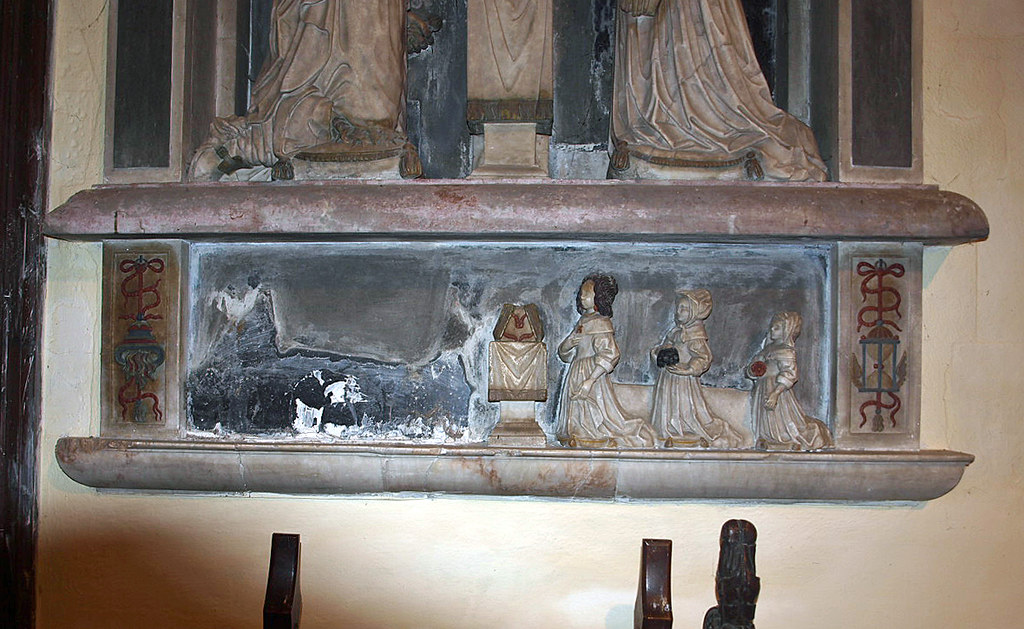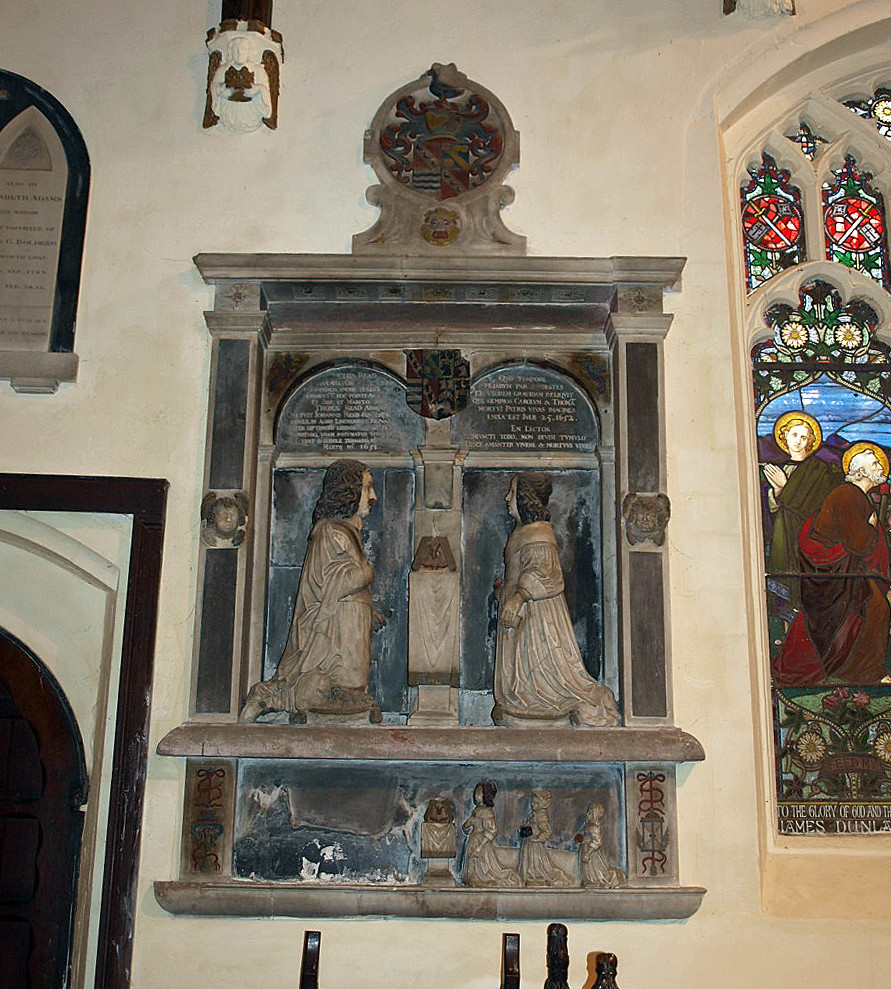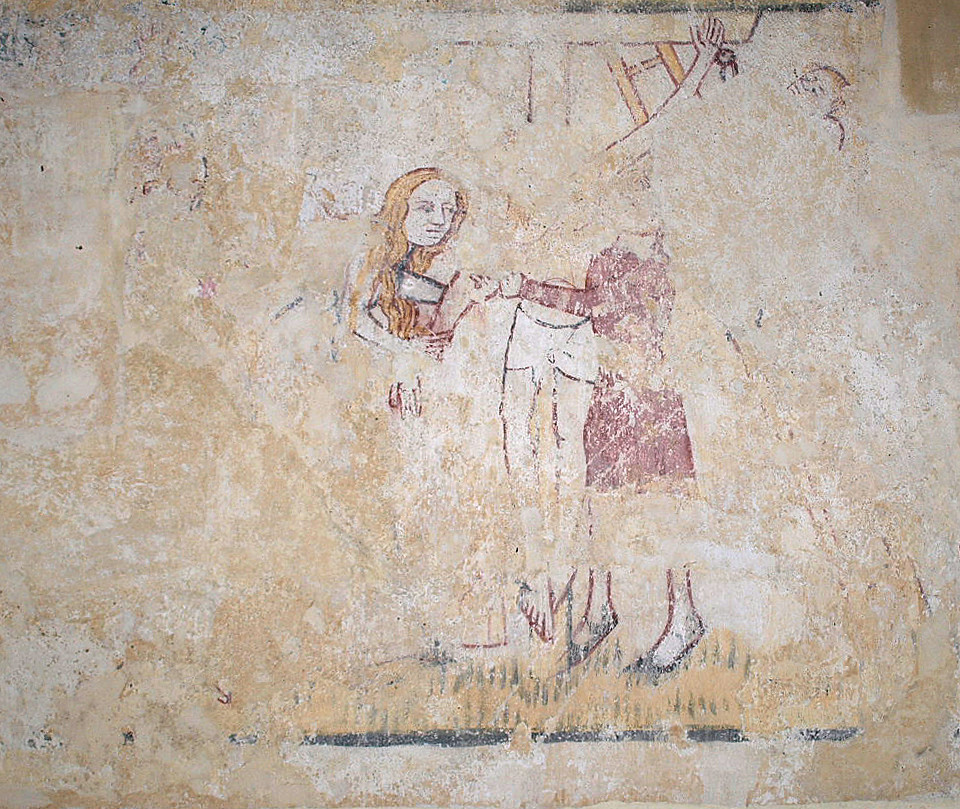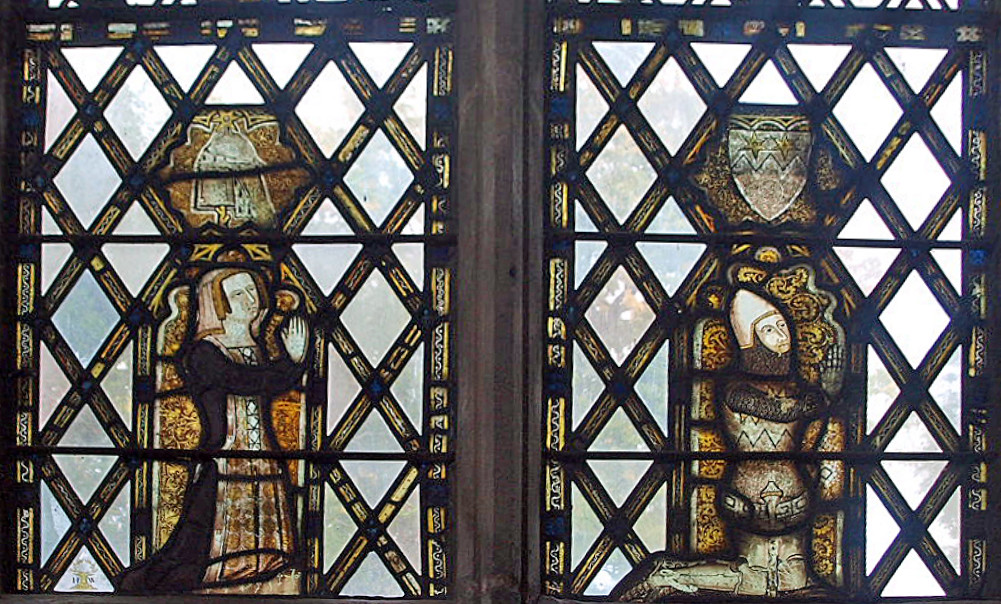Speaking of which, when Simon Knott visited in 2008 he recorded the seven children mentioned by Pevsner:
ST PETER AND ST PAUL. The biggest church in this neighbourhood. Tall Perp W tower with spike. Fine, tall Perp S porch with the arms of Sir William Berdewell who died in 1434.* Good flushwork decoration, chequerboard and panelling. Entrance with two orders of fleurons. Three niches around it. Side windows with fine tracery. Lofty nave with tall two-light Dec windows. Chancel of 1553. Excellent hammerbeam roof. Thin arched braces. Arched braces also below the ridge. No collar-beams. Of the angel figures which originally held the roof only four remain, one with the date 1421 on the opened pages of a book. Original colouring, including the charming trails on the rafters. - SCREEN. Four panels of a finely traceried dado. - STAINED GLASS. Three kneeling early C15 figures, the largest no doubt Sir William Berdewell. Also some C15 figures, including a German Pieta. - The chancel windows are by O’C0nnor, with dates in the 1860s. - PLATE. Two Cups and a Paten 1650; two Flagons 1678. - MONUMENT. Thomas Read and wife, dated 1652. Kneeling figures facing each other. In the ‘predella' seven children, one lying on its side, two next to it forming a pretty little group.
* A will of 1460 leaves 2s to the repair of the porch (ARA).
BARDWELL. We can see its church from Ixworth Thorpe, and its old houses and fine trees make a pleasant picture by the spacious Green. There is a bridge over the Blackbourne stream, an old watermill on the foundation of one mentioned in Domesday Book, and a windmill that has lost its sails. Here too are the broken walls of a ruined house built a century before Agincourt, the home of the Bardwells, whose joy it was to enrich the church. Wyken Hall in its park of 100 acres is mostly modern, but fragments of it are thought to be 13th century; and on the road to Ixworth is a gabled Tudor house, Bardwell Hall, with black bricks patterning its walls and twisted chimneys. It contains an ancient chapel.
Rather quaint is a gracious old building now used as almshouses, but once the Guildhall built by the Guild of St Peter in the 15th century. It is an old friend of the church on a little hill a stone’s throw away, one of the noblest churches to be seen for miles, with flint walls strengthened by fine buttresses, a handsome west door, and a great tower of which any village might be proud. It is crowned by a rather foolish little spire, the only undignified thing about it.
Remarkable even among the famous porches of Suffolk is the porch Sir William Bardwell built here more than 500 years ago, its walls imposing with stone panels filled by flints, its arch enriched by three fine niches and the arms of the builder. It is the rare work of a mason who may also have helped to build the porch at Honington, and is a splendid shelter for a grand old door. There is a big chancel arch with a peephole on each side, and a door to the rood stairs; but the things Bardwell cherishes most are in the imposing nave, with its ten lofty and finely traceried windows. They are the roof, the glass in the windows, and the old pictures under plaster on the walls.
The magnificent hammerbeam roof was the gift of Sir William Bardwell a year or two after Agincourt, and though many of its splendid angels have gone, a few are still here, one of them with an open book showing the date 1421, when the work was done. The great wooden beams rest on queer stone faces, and the rich carving must have delighted Sir William whenever he came to pray.
We see the sort of man he was in a window in the north wall, where a portrait shows him kneeling on a stool, his bare head ornamented with a chaplet. He has a moustache and a long beard, and is in armour with golden spurs. His sword is at his side, and hanging on the wall near by is the actual sword he carried when riding at the head of his company of archers. Among other fragments of old glass are portraits of the Drurys, a knight and his wife, he in armour and she in a short coat, a gown of white and gold, and a long purple train. Above are shields of great Suffolk families, their brilliant colours beautiful indeed. The 15th century glass in the west window includes birds and fruit and a Madonna with Our Lord.
The invisible treasures of Bardwell, its priceless old pictures on the nave walls, were seen for a little while in 1853 and then covered over again with plaster. Among them are a curious picture of the King of Terrors, a Last Judgment, and a St Christopher, painted about 1500. Three 14th century scenes show minstrels, the deadly sins, and the story of St Catherine.
Among many memories of the Reades in this place is a lovely monument in alabaster showing Thomas Reade of 1657 and his wife, kneeling at an altar with a white cloth heavily fringed. Surely carved by one who knew them in life, they have beautiful smiling faces; and just as lovely are their six children below - two little girls holding hands, their baby sister fast asleep, and others at a prayer desk holding red roses.
Flickr.
Rather quaint is a gracious old building now used as almshouses, but once the Guildhall built by the Guild of St Peter in the 15th century. It is an old friend of the church on a little hill a stone’s throw away, one of the noblest churches to be seen for miles, with flint walls strengthened by fine buttresses, a handsome west door, and a great tower of which any village might be proud. It is crowned by a rather foolish little spire, the only undignified thing about it.
Remarkable even among the famous porches of Suffolk is the porch Sir William Bardwell built here more than 500 years ago, its walls imposing with stone panels filled by flints, its arch enriched by three fine niches and the arms of the builder. It is the rare work of a mason who may also have helped to build the porch at Honington, and is a splendid shelter for a grand old door. There is a big chancel arch with a peephole on each side, and a door to the rood stairs; but the things Bardwell cherishes most are in the imposing nave, with its ten lofty and finely traceried windows. They are the roof, the glass in the windows, and the old pictures under plaster on the walls.
The magnificent hammerbeam roof was the gift of Sir William Bardwell a year or two after Agincourt, and though many of its splendid angels have gone, a few are still here, one of them with an open book showing the date 1421, when the work was done. The great wooden beams rest on queer stone faces, and the rich carving must have delighted Sir William whenever he came to pray.
We see the sort of man he was in a window in the north wall, where a portrait shows him kneeling on a stool, his bare head ornamented with a chaplet. He has a moustache and a long beard, and is in armour with golden spurs. His sword is at his side, and hanging on the wall near by is the actual sword he carried when riding at the head of his company of archers. Among other fragments of old glass are portraits of the Drurys, a knight and his wife, he in armour and she in a short coat, a gown of white and gold, and a long purple train. Above are shields of great Suffolk families, their brilliant colours beautiful indeed. The 15th century glass in the west window includes birds and fruit and a Madonna with Our Lord.
The invisible treasures of Bardwell, its priceless old pictures on the nave walls, were seen for a little while in 1853 and then covered over again with plaster. Among them are a curious picture of the King of Terrors, a Last Judgment, and a St Christopher, painted about 1500. Three 14th century scenes show minstrels, the deadly sins, and the story of St Catherine.
Among many memories of the Reades in this place is a lovely monument in alabaster showing Thomas Reade of 1657 and his wife, kneeling at an altar with a white cloth heavily fringed. Surely carved by one who knew them in life, they have beautiful smiling faces; and just as lovely are their six children below - two little girls holding hands, their baby sister fast asleep, and others at a prayer desk holding red roses.
Flickr.





No comments:
Post a Comment